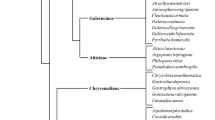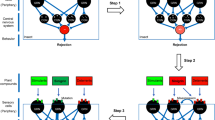Abstract
Here we show that larvae of the lycaenid butterfly Niphanda fusca secrete droplets containing trehalose and glycine. These droplets attract the larva’s host ants Camponotus japonicus, which collect and protect the larvae. We comparatively investigated gustatory preference for trehalose, glycine or a mixture of the two between host (C. japonicus) and non-host (Camponotus obscuripes) species of ants in behavioral and electrophysiological experiments. Glycine itself induced no taste sensation in either host or non-host ants. The mixture of trehalose plus glycine was chosen as much as pure trehalose by non-host ants. However, the host ants clearly preferred the mixture of trehalose plus glycine to trehalose alone. When we used sucrose instead of trehalose, the mixture of sucrose plus glycine was chosen as much as sucrose alone, in both species. These behavioral data are supported by the electrophysiological responsiveness to sugars and/or glycine in the sugar-taste receptor cells of the ants. Considering that lycaenid butterflies’ secretions have species-specific compositions of sugar and amino acid; our results clearly showed that such species-specific compositions of larval secretions are precisely tuned to the feeding preferences of their host ant species, in which the feeding preferences are synergistically enhanced by amino acid.






Similar content being viewed by others
Abbreviations
- DNO:
-
Dorsal nectary organ
References
Agrawal AA, Fordyce JA (2000) Induced indirect defence in a lycaenid–ant association: the regulation of a resource in a mutualism. Proc R Soc B 267:1857–1861
Als TD, Vila R, Kandul NP, Nash DR, Yen SH, Hsu YF, Mignault AA, Boomsma JJ, Pierce NE (2004) The evolution of alternative parasitic life histories in large blue butterflies. Nature 432:386–390
Axén AH, Leimar O, Hoffman V (1996) Signalling in a mutualistic interaction. Anim Behav 52:321–333
Bernays EA, Singer MS, Rodrigues D, Chapman RF, Hartmann T (2003) Loss of gustatory responses to pyrrolizidine alkaloids after their extensive ingestion in the polyphagous caterpillar Estigmene acrea. J Exp Biol 206:4487–4496
Blüthgen N, Fiedler K (2004a) Competition for composition: lessons from nectar-feeding ant communities. Ecology 85:1479–1485
Blüthgen N, Fiedler K (2004b) Preferences for sugars and amino acids and their conditionality in a diverse nectar-feeding ant community. J Anim Ecol 73:155–166
Blüthgen N, Fiedler K, Gottsberger G (2004) Sugar and amino acid composition of ant-attended nectar and honeydew sources from an Australian rainforest. Austral Ecol 29:418
Chapman RF, Bernays EA, Singer MS, Hartmann T (2003) Experience influences gustatory responsiveness to pyrrolizidine alkaloids in the polyphagous caterpillar, Estigmene acrea. J Comp Physiol A 189:833–841
Chaudhari N, Landin AM, Roper SD (2000) A metabotropic glutamate receptor variant functions as a taste receptor. Nat Neurosci 3:113–119
Chyb S, Dahanukar A, Wickens A, Carlson JR (2003) Drosophila Gr5a encodes a taste receptor tuned to trehalose. Proc Natl Acad Sci USA 100:14526–14530
Clyne PJ, Warr CG, Carlson JR (2000) Candidate taste receptors in Drosophila. Science 287:1830–1834
Cushman JH, Rashbrook VK, Beattie AJ (1994) Assessing benefits to both participants in a lycaenid–ant association. Ecology 75:1031–1041
Dahanukar A, Foster K, van der Goes van Naters WM, Carlson JR (2001) A Gr receptor is required for response to the sugar trehalose in taste neurons of Drosophila. Nat Neurosci 4:1182–1186
Daniels H, Gottsberger G, Fiedler K (2005) Nutrient composition of larval nectar secretions from three species of myrmecophilous butterflies. J Chem Ecol 31:2805–2821
Del Campo ML, Miles CI (2003) Chemosensory tuning to a host recognition cue in the facultative specialist larvae of the moth Manduca sexta. J Exp Biol 206:3979–3990
Dunipace L, Meister S, McNealy C, Amrein H (2001) Spatially restricted expression of candidate taste receptors in the Drosophila gustatory system. Curr Biol 11:822–835
Fiedler K (1998) Lycaenid–ant interactions of the Maculinea type: tracing their historical roots in a comparative framework. J Insect Conserv 2:3–14
Fiedler K, Hölldobler B, Seufert P (1996) Butterflies and ants: the communicative domain. Experientia 52:14–24
Fraser AM, Axén AH, Pierce NE (2001) Assessing the quality of different ant species as partners of a myrmecophilous butterfly. Oecologia 129:452–460
Glendinning JI, Ensslen S, Eisenberg ME, Weiskopf P (1999) Diet-induced plasticity in the taste system of an insect: localization to a single transduction pathway in an identified taste cell. J Exp Biol 202:2091–2102
Heath A, Claassens AJM (2003) Ant-association among southern African Lycaenidae. J Lepid Soc 57:1–16
Hill CA, Fox AN, Pitts RJ, Kent LB, Tan PL, Chrystal MA, Cravchik A, Collins FH, Robertson HM, Zwiebel LJ (2002) G protein-coupled receptors in Anopheles gambiae. Science 298:176–178
Hodgson ES, Lettvin JY, Roeder KD (1955) Physiology of a primary chemoreceptor unit. Science 122:417–418
Jordano D, Thomas CD (1992) Specificity of an ant-lycaenid interaction. Oecologia 91:431–438
Kay A (2004) The relative availabilities of complementary resources affect the feeding preferences of ant colonies. Behav Ecol 15:63–70
Lanza J (1991) Response of fire ants (Formicidae: Solenopsis invicta and S. geminata) to artificial nectars with amino acids. Ecol Entomol 16:203
Leimar O, Axén AH (1993) Strategic behaviour in an interspecific mutualism: interactions between lycaenid larvae and ants. Anim Behav 46:1177–1182
Maschwitz U, Wüst M, Schurian K (1975) Bläulingsraupen als Zuckerlieferanten für Ameisen. Oecologia 18:17–21
Nagayama H (1950) Life history of Niphanda fusca Bremer et Grey. Insect Ecol 3:9–18
Nelson G, Chandrashekar J, Hoon MA, Feng L, Zhao G, Ryba NJP, Zuker CS (2002) An amino-acid taste receptor. Nature 416:199–202
Nomura K, Hirukawa N, Yamaoka R, Imafuku M (1992) Problems on the symbiosis between the lycaenid butterfly larva, Niphanda fusca shijimia and the ants Camponotus (Camponotus) japonicus. Tyô to Ga 43:138–143
Pierce NE (1985) Lycaenid butterflies and ants: Selection for nitrogen-fixing and other protein-rich food plants. Am Nat 125:888–895
Pierce NE (1987) The evolution and biogeography of associations between lycaenid butterflies and ants. In: Harvey PH, Partridge L (eds) Oxford surveys in evolutionary biology, vol IV. Oxford University Press, Oxford, pp 89–116
Pierce NE, Nash DR (1999) The Imperial Blue: Jalmenus evagoras (Lycaenidae). In: Kitching RL, Sheermeyer E, Jone RE, Pierce NE (eds) The biology of Australian butterflies. CSIRO, Sydney, pp 277–313
Pierce NE, Braby MF, Heath A, Lohman DJ, Mathew J, Rand DB, Travassos MA (2002) The ecology and evolution of ant association in the Lycaenidae (Lepidoptera). Annu Rev Entomol 47:733–771
Robertson HM, Wanner KW (2006) The chemoreceptor superfamily in the honey bee, Apis mellifera: expansion of the odorant, but not gustatory, receptor family. Genome Res 16:1395–1403
San Gabriel A, Uneyama H, Yoshie S, Torii K (2005) Cloning and characterization of a novel mGluR1 variant from vallate papillae that functions as a receptor for l-glutamate stimuli. Chem Senses 30:i25–i26
Scott K, Roscoe Brady J, Cravchik A, Morozov P, Rzhetsky A, Zuker C, Axel R (2001) A chemosensory gene family encoding candidate gustatory and olfactory receptors in Drosophila. Cell 104:661–673
Tanimura T, Isono K, Takamura T, Shimada I (1982) Genetic dimorphism in the taste sensitivity to trehalose in Drosophila melanogaster. J Comp Physiol A 147:433–437
Völkl W, Woodring J, Fischer M, Lorenz MW, Hoffmann KH (1999) Ant-aphid mutualism: the impact of honeydew production and honeydew sugar composition on ant preferences. Oecologia 118:483–491
Wada A, Isobe Y, Yamaguchi S, Yamaoka R, Ozaki M (2001) Taste-enhancing effects of glycine on the sweetness of glucose: a gustatory aspect of symbiosis between the ant, Camponotus japonicus, and the larvae of the lycaenid butterfly, Niphanda fusca. Chem Senses 26:983–992
Wagner D (1993) Species-specific effects of tending ants on the development of lycaenid butterfly larvae. Oecologia 96:276–281
Wieczorek H, Wolff G (1989) The labellar sugar receptor of Drosophila. J Comp Physiol A 164:825–834
Yao I, Akimoto S-I (2002) Flexibility in the composition and concentration of amino acids in honeydew of the drepanosiphid aphid Tuberculatus quercicola. Ecol Entomol 27:745–752
Acknowledgments
We are grateful to David H. Hembry for helpful comments on the manuscript and language revision and two anonymous referees for their valuable comments. We thank Yasuhisa Endo for his help in scanning electron microscope, Hiroshi Oyama and Mayuko Shiraga for their help in chemical analysis, and Takeshi Takeda, Yuji Satoji, Daisuke Imaeda, Hayato Inui and Daisuke Umemoto for their help with collecting our study animals. All work presented here complied with the ‘‘Principles of animal care’’, publication No. 86–23, revised 1985 of the National Institute of Health, and also with the current laws of Japan, where these experiments were performed.
Author information
Authors and Affiliations
Corresponding author
Rights and permissions
About this article
Cite this article
Hojo, M.K., Wada-Katsumata, A., Ozaki, M. et al. Gustatory synergism in ants mediates a species-specific symbiosis with lycaenid butterflies. J Comp Physiol A 194, 1043–1052 (2008). https://doi.org/10.1007/s00359-008-0375-6
Received:
Revised:
Accepted:
Published:
Issue Date:
DOI: https://doi.org/10.1007/s00359-008-0375-6




